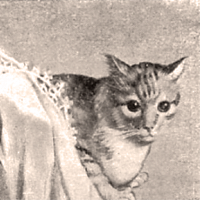Some fun news, I've starting writing a regular column for the new Italian embroidery magazine Giuliana Ricama that I told you about here. They have graciously permitted me to print an English translation of my column here on my blog when each issue that it appears in has come out. So, if you're in Italy and you'd like to read the article in Italian, you'll have to contact the magazine, but for those English speakers, it is below. Please note that the photos of the actual embroidery did not appear in the magazine due to technical issues and the photo of the original etching print does not appear here on my blog because the magazine purchased permission to use it and my blog did not.
One more thing: the photos of this embroidery were sent to me by a lady who contacted me trying to find out something about the piece that she had found at an antiques shop in the U.S. The photos are hers and are used here with permission.
----------------------------------
Printwork Embroidery is a technique of embroidery that imitates engraving artwork prints and was very popular in the first half of the 1800s. It then experienced a great revival after the The Great Exposition of London in 1851 where a masterpiece of the technique which featured a young girl embroidering surrounded by the alpine countryside was exhibited by the Swiss embroiderer J.U. Tanner.
Catalogues of Italian expositions of the period attest to many prizes being awarded for excellence in this technique as we can deduce from this quote: "...printwork embroidery in silk (awarded) for accuracy and fineness of work and for the well-understood application of shading". (Provincial Exposition of Industry and Agriculture held in Parma, 1871.) In that catalogue there are a dozen prizes which were awarded to this technique alone.
The photos are of a piece that was found at an antiques shop in Crystal River, Florida in the U.S. about 20 years ago. It is a work that is executed with great skill by an embroiderer whose name we know: Luigia Muzio. Dimensions of the piece are 18cm x 12cm and everything is stitched except the date which is printed in ink with a stain around it. After it was purchased, it was reframed using archival materials to ensure it's protection. The ground fabric is silk while the thread is difficult to determine whether it is very fine silk or hair. The embroidery is in good condition with the exception of a bit of deterioration at the top corners. The dedication reads: "For M. Maria Elisabetta Simons in thanks Muzio Luigia stitched 1869".
Depicted is Felice Orsini (1819-1858) an Italian patriot who became famous for his attempt to assassinate Napoleon III on the 14th of January 1858 and for which he was later guillotined in Paris that same year.
The original artwork print is signed Masutti (which could be the artist Antonio Masutti, 1813-1895) and today is part of the collection of the Risorgimento Museum in Turin, Italy. The embroidered copy meanwhile, can be found with the American lady who found it at her home in North Carolina. It is unknown if the embroidery was executed in Italy or in America.
----------------------------------
(The subject of the print is Felice Orsini making bombs of his own design in his room in England where he tested them before making the attempt on the life of the French Emperor in Paris.)
Thank so much to Susan for permission to use her photos and for the wonderful adventure of investigating this interesting piece!












